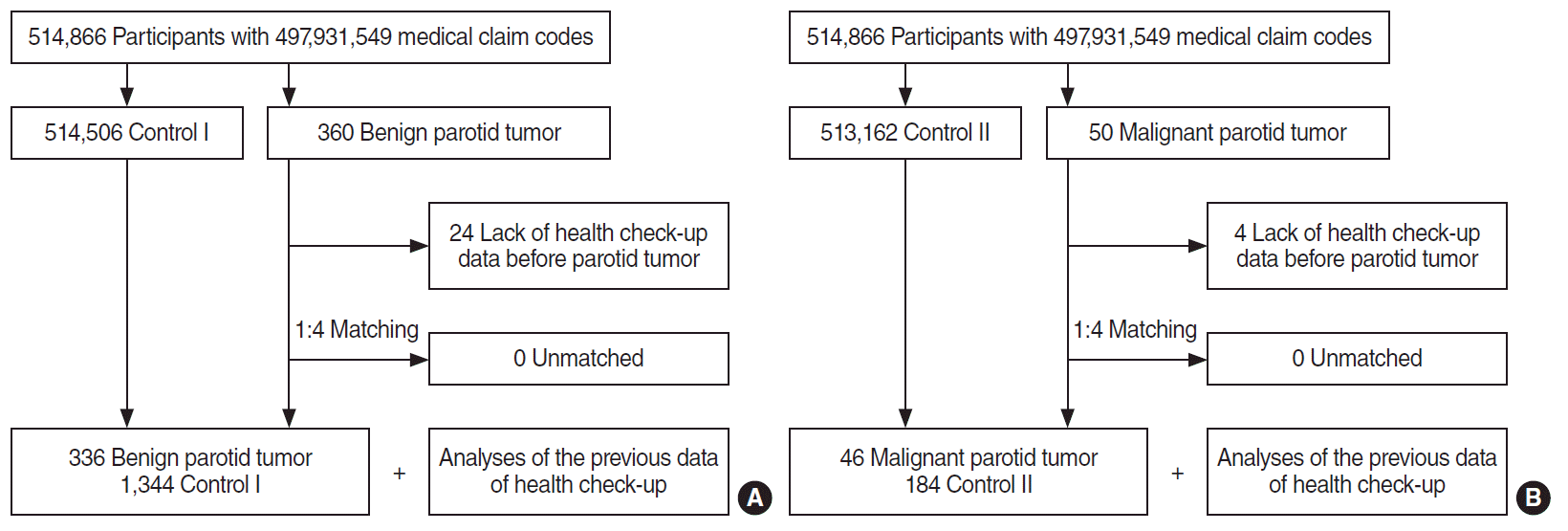2. Bailey BJ, Calhoun KH. Atlas of head & neck surgery: otolaryngology. New York, NY: Lippincott Williams & Wilkins;2001.
3. Bradley PJ, McGurk M. Incidence of salivary gland neoplasms in a defined UK population. Br J Oral Maxillofac Surg. 2013; Jul. 51(5):399–403.

4. Pinkston JA, Cole P. Incidence rates of salivary gland tumors: results from a population-based study. Otolaryngol Head Neck Surg. 1999; Jun. 120(6):834–40.

5. Barnes L, Eveson JW, Reichart P, Sidransky D. Pathology and genetics of head and neck tumours. Lyon: IARC Press;2005.
6. Sadetzki S, Chetrit A, Jarus-Hakak A, Cardis E, Deutch Y, Duvdevani S, et al. Cellular phone use and risk of benign and malignant parotid gland tumors: a nationwide case-control study. Am J Epidemiol. 2008; Feb. 167(4):457–67.
7. Shebl FM, Bhatia K, Engels EA. Salivary gland and nasopharyngeal cancers in individuals with acquired immunodeficiency syndrome in United States. Int J Cancer. 2010; May. 126(10):2503–8.

8. Lee J, Lee JS, Park SH, Shin SA, Kim K. Cohort profile: The National Health Insurance Service-National Sample Cohort (NHIS-NSC), South Korea. Int J Epidemiol. 2017; Apr. 46(2):e15.

9. Van Cauwenberge P, Van Hoecke H, Kardos P, Price D, Waserman S. The current burden of allergic rhinitis amongst primary care practitioners and its impact on patient management. Prim Care Respir J. 2009; Mar. 18(1):27–33.

10. National Health Insurance Service. National Health Insurance Sharing Service [Internet]. Wonju: National Health Insurance Service;2019 [cited 2019 Mar 24]. Available from:
https://nhiss.nhis.or.kr/bd/ab/bdaba001cv.do.
11. Song SO, Jung CH, Song YD, Park CY, Kwon HS, Cha BS, et al. Background and data configuration process of a nationwide population-based study using the korean national health insurance system. Diabetes Metab J. 2014; Oct. 38(5):395–403.

12. World Health Organization. The Asia-Pacific perspective: redefining obesity and its treatment. Sydney: Health Communications Australia;2000.
13. Sadetzki S, Oberman B, Mandelzweig L, Chetrit A, Ben-Tal T, JarusHakak A, et al. Smoking and risk of parotid gland tumors: a nationwide case-control study. Cancer. 2008; May. 112(9):1974–82.
14. Spitz MR, Fueger JJ, Goepfert H, Newell GR. Salivary gland cancer: a case-control investigation of risk factors. Arch Otolaryngol Head Neck Surg. 1990; Oct. 116(10):1163–6.

15. Yu GY, Liu XB, Li ZL, Peng X. Smoking and the development of Warthin’s tumour of the parotid gland. Br J Oral Maxillofac Surg. 1998; Jun. 36(3):183–5.

16. Kotwall CA. Smoking as an etiologic factor in the development of Warthin’s tumor of the parotid gland. Am J Surg. 1992; Dec. 164(6):646–7.

17. Lee YM, Choi HJ, Kim JW, Kim JH. Parotid gland tumors in a Korean population. J Craniofac Surg. 2012; May. 23(3):e205–9.

18. Moeller K, Esser D, Boeger D, Buentzel J, Hoffmann K, Jecker P, et al. Parotidectomy and submandibulectomy for benign diseases in Thuringia, Germany: a population-based study on epidemiology and outcome. Eur Arch Otorhinolaryngol. 2013; Mar. 270(3):1149–55.

19. Gove WR, Hughes M. Possible causes of the apparent sex differences in physical health: an empirical investigation. Am Sociol Rev. 1979; Feb. 44(1):126–46.

20. Gunn A, Parrott NR. Parotid tumours: a review of parotid tumour surgery in the Northern Regional Health Authority of the United Kingdom 1978-1982. Br J Surg. 1988; Nov. 75(11):1144–6.

21. Pinkston JA, Cole P. Cigarette smoking and Warthin’s tumor. Am J Epidemiol. 1996; Jul. 144(2):183–7.

22. Horn-Ross PL, Ljung BM, Morrow M. Environmental factors and the risk of salivary gland cancer. Epidemiology. 1997; Jul. 8(4):414–9.

23. Zheng W, Shu XO, Ji BT, Gao YT. Diet and other risk factors for cancer of the salivary glands: a population-based case-control study. Int J Cancer. 1996; Jul. 67(2):194–8.

24. Muscat JE, Wynder EL. A case/control study of risk factors for major salivary gland cancer. Otolaryngol Head Neck Surg. 1998; Feb. 118(2):195–8.

25. Spitz MR, Tilley BC, Batsakis JG, Gibeau JM, Newell GR. Risk factors for major salivary gland carcinoma: a case-comparison study. Cancer. 1984; Nov. 54(9):1854–9.

26. Radoi L, Barul C, Menvielle G, Carton M, Matrat M, Sanchez M, et al. Risk factors for salivary gland cancers in France: results from a case-control study, the ICARE study. Oral Oncol. 2018; May. 80:56–63.
27. Pan SY, de Groh M, Morrison H. A case-control study of risk factors for salivary gland cancer in Canada. J Cancer Epidemiol. 2017; 2017:4909214.

28. Suba Z, Barabas J, Szabo G, Takacs D, Ujpal M. Increased prevalence of diabetes and obesity in patients with salivary gland tumors. Diabetes Care. 2005; Jan. 28(1):228.

29. Maier H, Born IA, Mall G. Effect of chronic ethanol and nicotine consumption on the function and morphology of the salivary glands. Klin Wochenschr. 1988; 66 Suppl 11:140–50.
30. Bagnardi V, Blangiardo M, La Vecchia C, Corrao G. Alcohol consumption and the risk of cancer: a meta-analysis. Alcohol Res Health. 2001; 25(4):263–70.





 PDF
PDF Citation
Citation Print
Print



 XML Download
XML Download